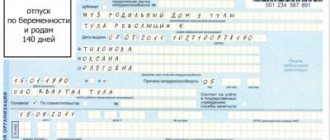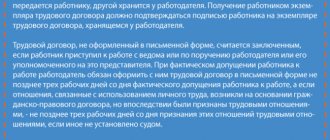Home / Labor Law / Employment / Hiring
Back
Published: 05/09/2017
Reading time: 7 min
0
798
A dismissed employee can return to his previous employer for the purpose of employment.
A new employment contract will be drawn up with him, and his personal file will undergo changes .
- Legislation
- Cases of re-employment
- Registration of documents Personnel number
- Card T-2
- Private bussiness
- Vacation
Dear readers! To solve your problem, call hotline 8 or ask a question on the website. It's free.
Ask a Question
Legislation
The Labor Code does not divide employees into “new” and “old”, therefore, when employing a former employee, the registration procedure will be standard. According to Article 65 of the Labor Code, the applicant must be required to provide documents (in originals):
- passport or temporary ID;
- work book (if it is not a part-time job);
- SNILS;
- military ID (if necessary);
- University diplomas, certificates, certificates of retraining, certificates of retraining (if the position and profession require special knowledge);
- medical certificate (if the work is “harmful”).
In addition, for accounting you will need:
- copies of children’s birth certificates (for calculating the deduction);
- a certificate from the previous place of work about income and transferred contributions.
After receiving the documents, the personnel officer formalizes the applicant:
- fills out an application for admission;
- draws up an employment contract;
- introduces local acts;
- prepares an order;
- fills out a work book.
https://youtu.be/rO7eJTbPnCw
Regulations on adaptation of newly hired employees
PREFACE 1. The Regulations were developed by the Personnel Management Directorate of OJSC VVV (hereinafter referred to as the Company). 2. To be put into effect from “___”__________200_. 3. This provision does not contradict the legislation of the Russian Federation and is of a normative nature. 4. Entered for the first time. CONTENTS 1. Purpose 2. Scope 3. Definitions, designations, abbreviations 4. Responsibility 5. General provisions 6. Adaptation program 7. Reporting on adaptation programs Appendix. Standard form for writing an adaptation plan for a newly hired employee 1. Purpose 1.1. These Regulations establish the requirements for conducting the adaptation process and assessing the effectiveness of the adaptation program for newly hired employees of the Company. 2. Scope of application 2.1. This Regulation is a regulatory document and applies to all divisions of the Company. 3. Definitions, designations, abbreviations 3.1. The following abbreviations are used in these Regulations: Regulations – Regulations of the Company; DUP - Directorate for Personnel Management; RSS - managers, specialists and employees. 4. Responsibility Responsibility for compliance with the requirements of these Regulations rests with the DUP and heads of departments. 5. General provisions 5.1 The personnel adaptation program is a set of measures aimed at accelerating the process of adaptation of newly hired managers and specialists to working conditions and the specifics of the enterprise. 5.2 The adaptation program is implemented in accordance with a set of socio-psychological adaptation measures defined by these Regulations and is aimed at familiarizing and assimilating the newly hired specialist with corporate values and rules of behavior at the enterprise. 5.3 The adaptation process includes the following 4 aspects:
- professional;
- psychophysiological;
- socio-psychological;
- organizational.
Professional adaptation - mastering the subtleties and specifics of the profession required in a given production. To speed up the process of professional adaptation of newly hired employees, the following activities are planned to be organized and carried out: - job interviews, preliminary assessment of a specialist by the head of the department; — on-the-job training; — mentoring; — rotation. Psychophysiological adaptation is the employee’s adaptation to working conditions, work and rest schedules. Depends on human health, his natural reactions, characteristics of working conditions. To speed up the process of psychophysiological adaptation of newly hired employees, the following activities are planned: - familiarization with the workplace; — safety briefing; — bringing to the attention of the Labor Regulations. Social and psychological adaptation is the inclusion of an employee in the system of relationships of the team with its traditions, norms of life, and value orientations. During such adaptation, the employee receives information about the system of business and personal relationships in the team and individual formal and informal groups, and about the social positions of individual group members. To speed up the process of socio-psychological adaptation of newly hired employees, the following is provided: - participation in the Adaptation Program Day; — appointment of a personal curator; — participation in communication trainings. Organizational adaptation - familiarization with the features of the organizational and economic mechanism of enterprise management, the place of one’s unit and position in the overall system of goals and in the organizational structure, understanding one’s own role in the overall production process. To speed up the process of organizational adaptation of newly hired employees, it is planned to become familiar with such materials as: - the mission of the enterprise, goals and objectives; — corporate policy, corporate values; — organizational structure of the enterprise; — the organization’s policy in the field of personnel management; — rationing and remuneration. 6. Adaptation program Currently, the Company practices hiring employees with a probationary period, which gives the opportunity to evaluate the candidate directly at the workplace without assuming obligations for permanent employment (2 months provided for by the Labor Code, when an employee can be considered temporary). During this period, the head of the department where the newly hired employee arrives must pay special attention to him in order to evaluate him from the point of view of his potential to work in this workplace. To increase the effectiveness of the trial period, it is recommended that the department head and the candidate jointly determine the final goal of the trial and then evaluate the results. The proposed adaptation program for newly hired PKK employees includes several stages. Stage 1 - Preliminary Takes place directly when a person is hired. The DUP is carried out when applying for a job, by the line manager during an interview, and by the Safety Department during briefing. At this stage, the newly hired employee is introduced to the history of the creation and development of the Company, mission, corporate values, working conditions and rules of conduct at the enterprise; explain the tasks and requirements for the work, appoint a supervisor. Supervisor - RSS, with at least 1 year of work experience at the enterprise, who is the immediate line manager of the newly hired employee. The curator must be a comprehensively developed person, have organizational skills, have a desire for self-education, and an active life position. The supervisor draws up an adaptation plan for a newly hired employee in accordance with the standard form for writing an adaptation plan (Appendix No. 1), where he determines the timing of implementation of adaptation measures and the responsible persons. On the basis of this document, at the end of the probationary period, a report on the passage (failure) of the probationary period by the employee of the unit is heard. DUP provides methodological guidance to curators: - conducts classes with curators; — provides consulting support; — evaluates the work of curators based on the theoretical knowledge and practical skills of newly hired employees. Stage 2 - Introductory At this stage, the newly hired employee is integrated into the team, as well as the employee receives information about the enterprise as a whole, about the department and the workplace where he begins to work. In accordance with the individual adaptation plan, the employee becomes familiar with the workplace, features of document flow, manufactured products, management structure, including the names of key managers, internal regulations, basic Company procedures, employee benefits, opportunities for advanced training and professional growth. A necessary condition for the successful integration of newly hired employees is the presence of feedback - providing the new employee with the opportunity to ask questions and get answers to them. To implement the introductory stage, the following activities are proposed: — familiarization with the location of the Company’s divisions; — participation in the Adaptation Program Day; — planning working hours jointly with the supervisor (day, week, month). Onboarding day is held for all employees hired within the last month. In terms of events - a tour of the enterprise; — a series of introductory lectures (speeches) on the Company’s corporate policy, labor regulations, etc. — meeting with the management of the enterprise. Onboarding program participants receive an Employee Handbook and a gift set containing branded products. The Employee Handbook includes materials with a brief history of the Company, an explanation of policies regarding labor issues (hiring, dismissal, transfers, layoffs), occupational health and safety rules. This may include some telephone numbers (medical services, security services, DUP, Occupational Safety and Health Administration, etc.). It may also contain the content of social programs, a description of areas of professional training, and advanced training programs. This brochure may contain a list of information constituting a trade secret, rules for the protection of documentation, etc. Stage 3 - Final The completion of the integration process can be considered the independent functioning of the employee, the gradual overcoming of production and interpersonal problems and the transition to stable work. At this stage, the employee’s personal work plan is drawn up, reflecting all areas of work, the adaptation process of the newly hired employee is analyzed and adjusted, and the employee is individually supported by a supervisor. At the end of the probationary period, a report on the completion of the probationary period is heard and a decision is made on passing (failing) the test and concluding a contract with the employee. The decision to pass (or not pass) the probationary period must be made no later than 3 days before the end of the probationary period, of which the employee is notified orally or in writing. 7. Reporting on adaptation programs 7.1. After completing the program, program participants provide the DUP with the paper documents necessary for reporting: - a copy of the individual adaptation plan; — a copy of the final conclusion about the adaptation process. The success of adaptation can be judged on the basis of a number of indicators: - efficiency of work activity; — active participation of employees in the Company’s activities; — compliance of qualifications with the requirements of the workplace; — compliance of the individual’s behavior with the norms established in the given team; — fatigue; — employee satisfaction with the job as a whole or its individual manifestations. 7.2. The financial documentation of the DUP is transferred to the financial department for further processing. 7.3. The DUP monthly, no later than the 10th day of the month following the reporting month, generates a monthly summary report on the adaptation of newly hired employees and the implementation of the Adaptation Program Day and submits it to the General Director of the Company for approval. Leading specialist in corporate culture __________________ Standard Controller Leading specialist in organizational planning _______________________ AGREED Deputy General Director - HR Director ________________________ Head of the Legal Department __________________________ Appendix 1 Standard form for writing a plan for a newly hired employee Employee _________________________________________________ Supervisor _________________________________________________
| No. | Event name | Period of execution | Responsible | Completion mark |
| 1 | 2 | 3 | 4 | 5 |
| Stage I | ||||
| 1. | Drawing up an adaptation plan | |||
| 2. | History of the creation and formation of the Company, organizational structure, corporate values, modern personnel policy, working conditions and rules of conduct, development prospects | |||
| 3. | Familiarization with internal regulations | |||
| 4. Explanation of tasks and job requirements - functions of the unit; — job duties, responsibilities; — procedure for providing assistance in the adaptation process | ||||
| 5. | Workplace safety briefing | |||
| Stage II | ||||
| 6. | Structural and functional diagram of the department | |||
| 7. | Presentation to the department team | |||
| 8. | Familiarization with the workplace: - daily routine; — documents necessary to perform the work; - lunch break; — technical equipment of the workplace; - phonebook; — means of communication and rules for using them | |||
| 9. | Information exchange system | |||
| 10. | Communication system (reporting and control) | |||
| 11. | Familiarization with the location of the Company's divisions (addresses, focus, specifics) | |||
| 12. | Participation in the Adaptation Program Day | |||
| 13. | Presentation to managers and specialists with whom you will have to interact in the course of performing their functional duties | |||
| Stage III | ||||
| 14. | Drawing up a personal work plan reflecting all areas of work | |||
| 15. | Implementation of an individual work plan | |||
| 16. | Analysis and adjustment of adaptation process | |||
| 17. | Hearing a report on the completion of the probationary period and making a decision on passing (not passing) the probationary period | |||
The head of the department ____________________________________________ "___"_____________ 200_year The individual adaptation plan has been reviewed by _______________________ "___" _____________200_year
Cases of re-employment
In today's time of crisis, large enterprises hire specialists for seasonal work.
As soon as the season ends, laid-off employees are forced to temporarily find work in other companies in order to gain experience and not be left without income. Among the working population there are often people who often change jobs. Such employees, after working for some time in one company, go to another.
The reasons for migration are different: not fitting into the team, dissatisfaction with the administration, salary or working conditions.
An illegally dismissed employee can be reinstated by the court.
But in this case, re-employment is not required; an order is simply issued to invalidate the dismissal record.
The newcomer was not given an advance - what are the consequences?
There is no specific provision of law establishing liability for late payment of an advance to new employees or incorrect calculation of its amount.
However, an employer who deviates from legal requirements cannot avoid liability. In this situation, general rules apply, namely:
| Type of violation of labor laws | Type of responsibility | Punishment |
| Late payment (non-payment) of advance payment, wages | Administrative (Article 5.27 of the Administrative Code) | Primary violation - a fine for officials and individual entrepreneurs from 1,000 to 5,000 rubles, for a company - from 30,000 to 50,000 rubles; Repeated violation - a fine for officials and individual entrepreneurs from 10,000 to 20,000 rubles. or disqualification for a period of 1 to 3 years, per company - from 50,000 to 70,000 rubles. |
| Disciplinary (Article 192 of the Labor Code of the Russian Federation) | If the salary is not paid due to the fault of the manager (or other authorized person), this may be considered as improper performance of their official duties and lead to the imposition of one of the provisions provided for in Art. 192 of the Labor Code of the Russian Federation of disciplinary sanctions | |
| Material (Article 236 of the Labor Code of the Russian Federation) | The employer is obliged to pay (except for delayed wages) interest - not less than 1/150 of the key rate of the Central Bank of the Russian Federation in force at that time on amounts not paid on time for each day of delay, starting from the next day after the established payment deadline up to and including the day of actual settlement | |
| Criminal (Article 145.1 of the Criminal Code of the Russian Federation) | Partial non-payment of wages for more than 3 months, committed out of selfish or other personal interest by the head of an organization, an employer - an individual, the head of a branch, representative office or other separate structural unit of an organization, is punishable by a fine in the amount of up to 120,000 rubles, the salary or other income of the convicted person for the period up to 1 year, or deprivation of the right to hold certain positions or engage in certain activities for up to 1 year, or forced labor for up to 2 years, or imprisonment for up to 1 year. Complete non-payment of wages for more than 2 months (or payment of wages for more than 2 months in an amount below the minimum wage established by federal law, committed out of selfish or other personal interest by the head of the organization, the employer - an individual, the head of a branch, representative office or other separate structural unit of the organization - punishable by a fine in the amount of 100,000 rubles to 500,000 rubles or in the amount of wages or other income of the convicted person for a period of up to 3 years, or by forced labor for a period of up to 3 years with deprivation of the right to hold certain positions or engage in certain activities for a period of up to 3 years or without it, or imprisonment for up to 3 years with deprivation of the right to hold certain positions or engage in certain activities for up to 3 years or without it |
An employer cannot avoid punishment if an employee asks for a salary in one amount once a month and his request is not denied (letter of Rostrud dated November 30, 2009 No. 3528-6-1). You can see detailed explanations of this position from an official from the Ministry of Labor in K+, having received free trial access to the system.
If your employee asks to pay him an advance payment several months in advance, and you meet him halfway, arrange such payment in the form of a loan with a minimum interest rate. Otherwise, you may have all sorts of problems: the advance may be considered an interest-free loan (the need to withhold personal income tax from the amount of the benefit from saving on interest), and you will have to immediately pay insurance premiums, etc., on the entire amount.
An employer who has not paid an employee (new or long-time) for the first half of the month will not be punished only if this employee did not work in the first half of the month (appeal ruling of the Moscow Regional Court dated 08/07/2012 in case No. 33-15891 /2012).
Paperwork
Even if the applicant has already worked for the company, he must still provide the documents listed above . Because information appearing in a closed personal file may not be current.
The applicant could get married during the time that he did not work in the company, or change his passport, or give birth to a child.
Certain personal documents of the former employee are reissued with nuances.
Personnel Number
Upon employment, each employee is assigned a personnel number. He
is unique and appears in all accounting documents. The assignment of numbers is not regulated by law; everything depends on the rules adopted by the organization.
Today, accounting programs automatically assign personnel numbers to new employees; the personnel officer only needs to recognize it if he does not work in the same program.
But, you can also leave the previous number assigned to the former employee, if it is convenient for the personnel officer and accounting department.
Card T-2
The registration card is filled out anew, since information about vacations, the employment contract that was previously in force, and dismissal has already been entered into it. In addition, upon dismissal, the card is transferred to the company archives.
Private bussiness
Upon re-employment, a new personal file is opened, as required by the legal act - Rules for the Operation of Archives (clause 3.6.18). According to the norm of this paragraph, the storage of a personal file in the documents of the personnel department is determined by the period from the date of employment to the date of dismissal.
Vacation
Upon dismissal, the employee is compensated for vacation if it is not used in full.
That is, when re-employed, the period of work taken as the calculation of vacation days begins from the moment the new employment contract is concluded. According to the provisions of Article 121 of the Labor Code, an employee who has worked in the company for at least six months can count on vacation. And according to the rule of Article 122 of the Labor Code, the employee is entitled to regular paid leave for each working year.
Since the working year begins from the date of conclusion of the contract, the counting of working days giving the right to leave begins from the same date.
Postponement of holidays while on vacation - how to do it? How to properly and competently arrange your pension, read here. Read about raising the retirement age and related changes in payments in this article. We have the most detailed information!
Method for calculating advance payment when hiring
Establish in a local act the method for calculating the advance payment when hiring - it should not contradict the requirements of the law, which determines the calculation of the first and second salary payments based on the time actually worked.
Is it possible to set wages for the first half of the month at 40% of the salary and how to withhold personal income tax? You will find the answer to this question in ConsultantPlus. Get free access to the system and proceed to expert explanations.
It is impossible to establish an advance payment in a fixed amount for all employees - it is impossible to do without preliminary calculations.
In addition, you should take into account the requirements of legal acts and the opinion of officials regarding the minimum and maximum amounts of the advance:
| Advance amount | Opinion of officials and legislators | NPA |
| Minimum | The minimum amount of the advance must not be lower than the employee’s tariff rate for the time worked | Art. 129 Labor Code of the Russian Federation |
| Payment to an employee for half a month cannot be less than the tariff rate or salary for the time actually worked (the amount of work actually completed) | Letter of Rostrud dated 02/03/2016 No. 14-1/10/B-660 | |
| The advance is calculated on the basis of the salary (tariff rate) and bonuses to it (for part-time work, for work at night according to a schedule, etc.) Those payments that are determined based on the results of the completed month (bonus, overtime) should not be used when calculating the advance payment. | Letter of the Ministry of Labor of the Russian Federation dated August 10, 2017 No. 14-1/B-725 | |
| Maximum (not regulated by law) | It is necessary to calculate wages for every half month in approximately equal amounts (excluding bonus payments), since wages are paid at least twice a month | Letter of the Ministry of Health and Social Development of Russia dated February 25, 2009 No. 22-2-709 |
Why is it important to help an employee join the team?
This is, first of all, beneficial to the enterprise. Mistakes made by a newcomer in the process of work are excluded. And if his job responsibilities are related to production, then the possibility of producing defective products is minimized.
Adaptation to a new team can take quite a long time if you do not interfere with this process. And as a result, there will be many reasons why a person will want to quit. To prevent this from happening, motivation is needed, the newcomer must see the prospect of working at this enterprise. There are benefits to adapting personnel to an organization for both parties:
- the employee is provided with complete information for effective work, he masters the norms of corporate ethics at the enterprise, receiving satisfaction from work;
- the company is developing mechanisms for assessing the work of employees, identifying shortcomings in the personnel selection system, developing the management competencies of HR managers or mentors, and developing mechanisms for loyalty to employees.
Psychologists note that a change in the team and the work process as a whole, to which a person is accustomed, causes stress. It is important to help overcome this stage, eliminating the anxiety and nervousness of the newly hired employee.
Legislation of the Russian Federation on the right of an employee to dismiss at his own request
The employee’s rights to work, free disposal of it and the inadmissibility of forced labor are enshrined in Part 2 of Art. 37 of the Constitution of the Russian Federation. Based on these norms, it is obvious that no employer should interfere with the exercise of an employee’s right to dismissal on his own initiative, the procedure for which is enshrined in Art. 77 and 80 of the Labor Code of the Russian Federation.
Additional clarification regarding voluntary dismissal is provided by Rostrud’s letter “On the procedure for dismissal...” dated 09/05/2006 No. 1551-6. This letter states that dismissal of an employee on his own initiative is permitted, including during the periods:
- He is on vacation.
- He is on sick leave.
Deductions for children of former employees
Having hired a former employee, the accounting department is faced with the need to provide deductions for children.
| Situations | How to provide a deduction |
| The employee has not returned to his previous position since the beginning of the year | A tax deduction is provided to an employee from the month in which he was hired. If he did not get a job at the beginning of the year, then the amount of income is calculated taking into account payments at his previous place of work. This income is confirmed by a 2-NDFL certificate from the previous employer. If the certificate is not provided to them, then they do not have the right to deduction for the child. |
| After dismissal, the employee was not employed | If after dismissal the employee still does not find a job, then a standard deduction can be provided to him without a 2-NDFL certificate. The basis for the deduction is a statement from the employee himself, in which he indicates that this year he was not employed anywhere and had no income. |
| Last year's deduction | If an employee quit last year and did not work anywhere after that, then he does not need to provide deductions for the past period. For past periods, the employee himself applies to the tax office at his place of residence. |
Dismissal of a temporary worker
The situation becomes somewhat more complicated if the employee replacing the main one also intends to go on maternity leave. In this case, it is important for the employer to take into account all the legal nuances stipulating the possibility of dismissing a temporary worker, proper paperwork and the need to pay benefits.
The sequence of actions of the manager depends on the scenario:
- If a temporary employee is pregnant at the time the permanent employee returns, and there is no vacant position in the organization to which the woman could be transferred, dismissal is issued due to the expiration of the employment contract. But if the contract concluded with the replacement employee does not indicate a specific termination point, the employer will not be able to fire her.
- If a fixed-term contract of the established form was signed with a temporary employee, but by the time it expired it was discovered that the woman was expecting a child, upon her application and upon provision of the appropriate medical document, the contract should be extended until the end of the pregnancy.
- If at the time of the return of a permanent employee, a temporary one is on maternity leave, she can be fired due to the expiration of the contract.
Moreover, in the first case, the employer is obliged to offer the replacement worker all available vacancies that correspond to the woman’s qualifications (or require a lower level of preparedness) and can be filled by her, taking into account her state of health. If the employee has agreed to change her job function, then the fixed-term contract with her should be extended until the end of the pregnancy.
Cash payments
After dismissal during maternity leave, a woman has the right to apply for minimal financial assistance from the state social protection agency or from the Employment Center for unemployment payments. At the same time, the organization in which the employee worked at the time of going on leave is obliged to provide her with benefits for the entire period of maternity leave.
In addition, payments from the enterprise are due to the replacement worker if the woman:
- goes on maternity leave until the permanent employee returns to work;
- agrees to transfer to another position during pregnancy, as a result of which the employer extends the contract with her.
Signing a fixed-term employment contract with a replacement employee during the absence of a permanent one can cause the employer a lot of trouble.
To avoid the latter, the manager should treat the preparation of the necessary papers with full responsibility, and if any difficulties arise, try to resolve the problems with the employees amicably. If it is not possible to reach a peaceful agreement, only the court will be able to assess the correctness of the decisions made.
How to help a new employee adapt to the team
Many companies, firms, organizations are faced with the phenomenon of staff turnover.
This has an adverse effect on economic performance and slows down the development of the enterprise. The main reason for employee dismissal is the problem of adaptation in the workforce. This means that the manager did not take sufficient measures to retain newcomers in the workplace. Let's figure out what can be done to eliminate staff turnover.
First, you need to figure out what problems may arise for newly hired employees. This function should be assigned to the HR manager. Through the joint efforts of the director, manager and even employees of the enterprise, it is necessary to develop a technology or, in other words, a strategy for adapting new employees to the team.
It is necessary to take into account all the factors that influence a person in the process of being introduced to a new position and performing new responsibilities, and to establish communication between team members.
We recommend that you be guided by already proven principles and methods of personnel adaptation. If problems, conflicts, or discontent arise among employees in the process of organizing collective work, you should seek help from a psychologist. He will give practical advice regarding the specifics of carrying out adaptation activities.








